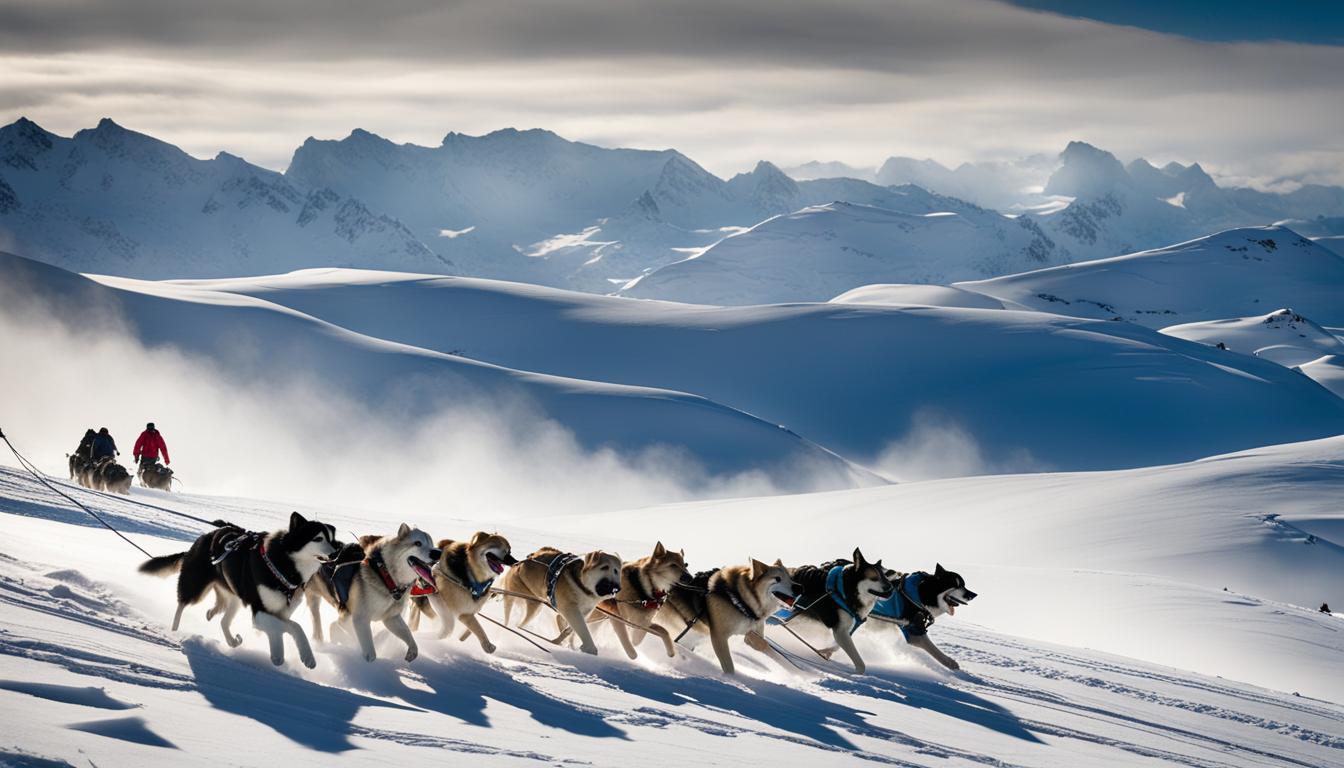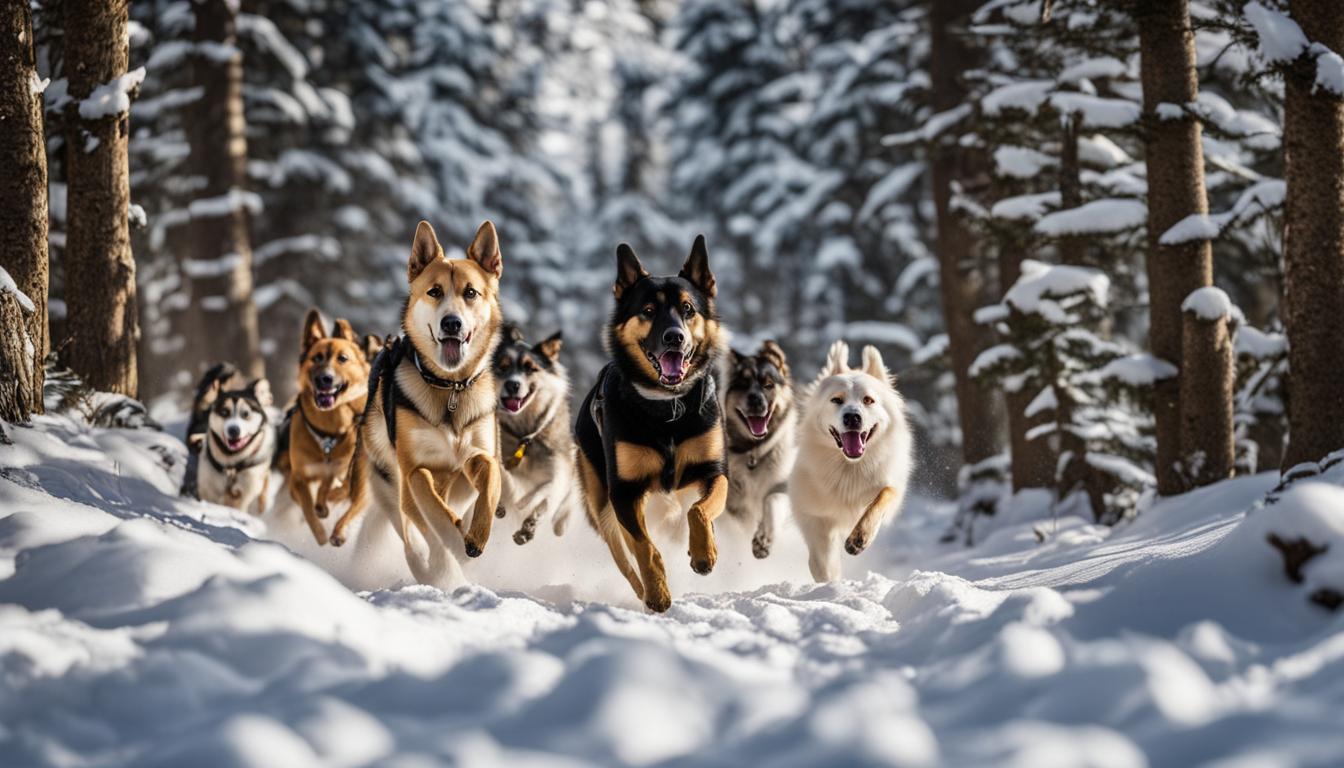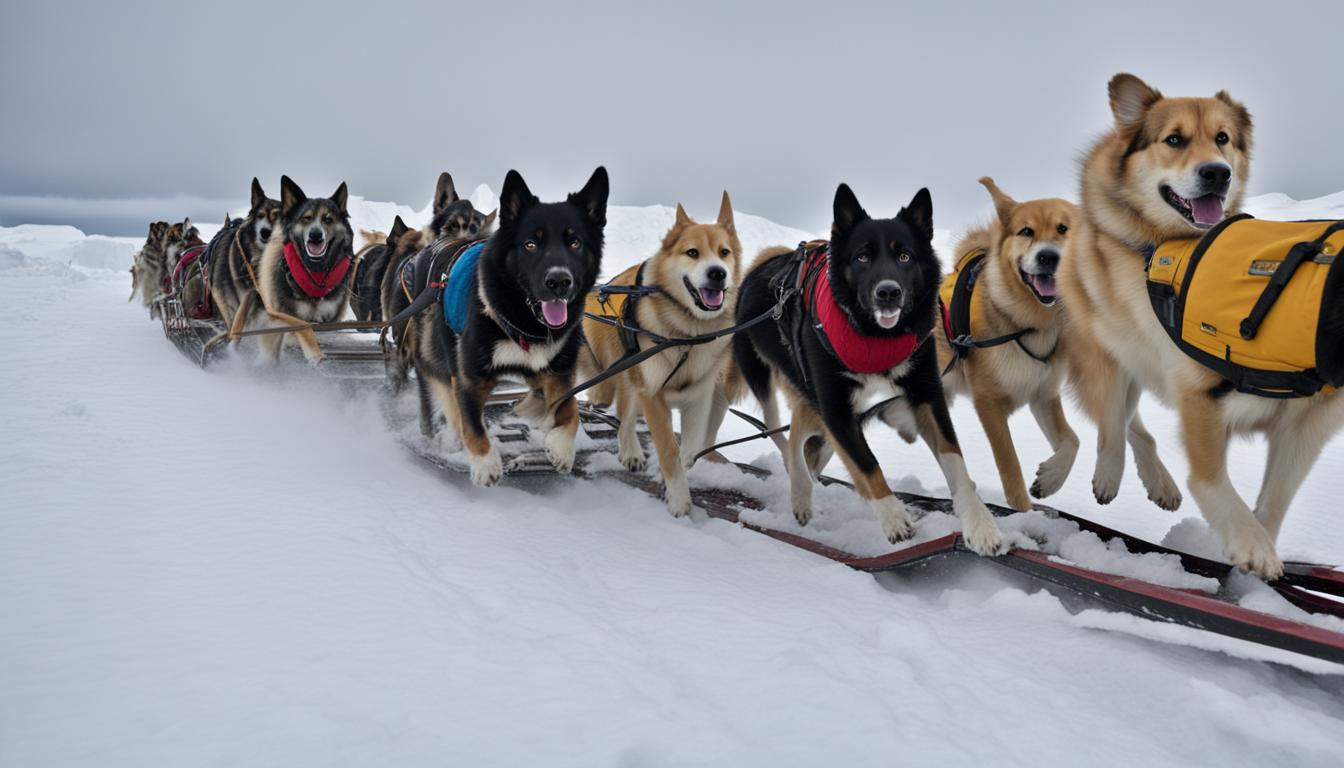Polar Expedition Dogs, also known as Arctic Exploration Dogs or Cold Climate Dog Breeds, are the true unsung heroes of Arctic expeditions. These incredible working dogs possess unique traits that enable them to conquer extreme cold temperatures and navigate treacherous terrains. From sled pulling to detecting dangers, these loyal and dedicated companions provide essential support to their human counterparts. Let’s delve deeper into the world of these remarkable sled dogs and discover the invaluable contributions they make in the icy frontiers.
Key Takeaways:
- Polar Expedition Dogs are specially bred and trained to withstand freezing temperatures and challenging conditions.
- These working dogs play a crucial role in transportation, search and rescue missions, and providing emotional support in Arctic expeditions.
- Arctic Adventure Canines, such as Alaskan Malamutes and Siberian Huskies, are some of the cold climate dog breeds that excel in polar exploration.
- Training and preparation of Polar Expedition Dogs focus on obedience, physical fitness, sled pulling techniques, and survival skills.
- The dedication, strength, and adaptability of these Snow Dogs make them invaluable assets in the challenging world of Arctic expeditions.
The Role of Polar Expedition Dogs in Arctic Exploration
Arctic Adventure Canines, also known as Working Dogs in Polar Regions, play an integral role in the world of Arctic exploration. These remarkable dogs, such as the Alaskan Malamute, Siberian Husky, and Greenland Dog, possess unique qualities that enable them to thrive in extreme conditions.
These Arctic Dog Breeds are known for their strength, endurance, and ability to navigate treacherous terrains with ease. They are not only skilled at pulling heavy loads for long distances as sled dogs but also assist in various other tasks during expeditions. Whether it’s aiding in search and rescue missions, assisting with scientific research, or providing emotional support to expedition members, these dogs are indispensable companions in the harsh Arctic environments.
The resilience and adaptability of these Working Dogs in Polar Regions have made them invaluable assets in Arctic exploration. With their unwavering loyalty and dedication, they have earned their place as unsung heroes in the icy frontiers. These Arctic Adventure Canines truly embody the spirit of adventure and companionship, making the world of Arctic exploration a safer and more successful endeavor.
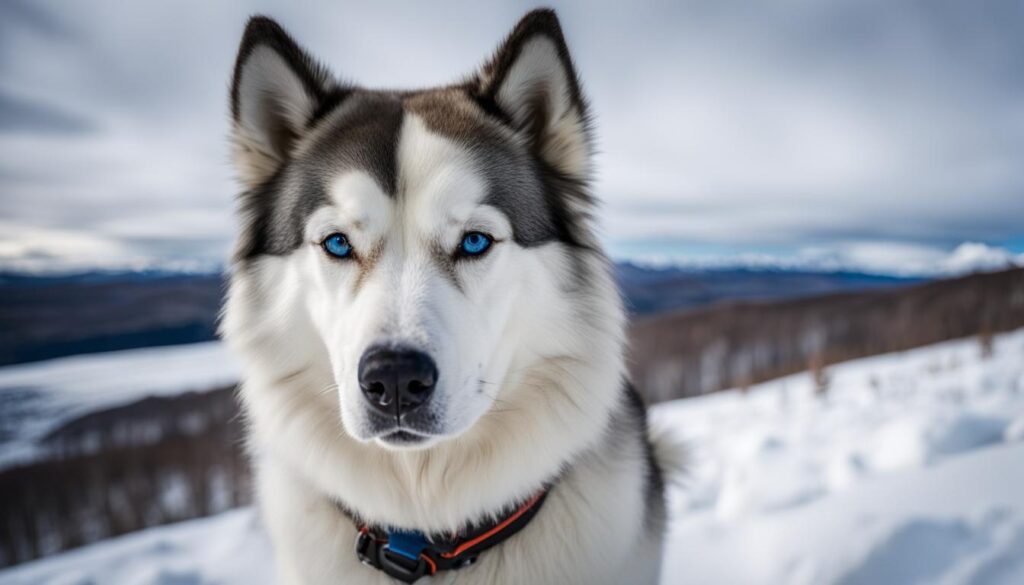
Table: Comparison of Arctic Dog Breeds
| Breed | Strength | Endurance | Temperament |
|---|---|---|---|
| Alaskan Malamute | Strong | High | Friendly, Affectionate |
| Siberian Husky | Moderate | High | Outgoing, Energetic |
| Greenland Dog | Strong | High | Independent, Loyal |
The table above provides a comparison of the three main Arctic Dog Breeds. While the Alaskan Malamute is known for its exceptional strength, the Siberian Husky excels in endurance. The Greenland Dog combines strength and endurance with a fiercely loyal temperament. Each breed brings its own unique qualities to Arctic expeditions, contributing to the success and safety of these challenging endeavors.
In conclusion, the role of Polar Expedition Dogs, or Arctic Adventure Canines, cannot be overstated in Arctic exploration. These Working Dogs in Polar Regions are vital members of expeditions, contributing their exceptional abilities, loyalty, and companionship. They are the unsung heroes that make Arctic expeditions possible, ensuring the exploration of the icy frontiers continues with success and admiration for their incredible contributions.
Training and Preparation of Polar Expedition Dogs
Winter Expedition Dogs, commonly referred to as Snow Dogs, are an integral part of polar expeditions. These remarkable canines undergo extensive training and preparation to become valuable members of Arctic exploration teams. From a young age, these dogs are raised and bred in cold climates, allowing them to develop the necessary physical attributes to thrive in freezing temperatures. Their thick fur, strong muscles, and endurance are essential for withstanding the harsh conditions of the Arctic.
Training for Snow Dogs begins with obedience and physical fitness. They are taught to follow commands and respond to their handlers, ensuring their safety and teamwork during expeditions. Additionally, they undergo sled pulling training, which involves mastering the techniques and mechanics of pulling heavy loads for long distances. This crucial skill allows them to transport supplies efficiently across icy landscapes.
Survival skills are also a key component of their training. Snow Dogs are taught to find food and water in frozen environments, ensuring their self-sufficiency during expeditions. They are acclimated to extreme temperatures and exposed to various types of terrain, including snow-covered mountains and icy lakes, to ensure they can navigate any situation they may encounter.
A Glimpse into the Training Regimen of Snow Dogs:
| Training Aspect | Description |
|---|---|
| Obedience | Teaches dogs to follow commands, ensuring their safety and teamwork during expeditions. |
| Sled Pulling | Focuses on mastering the techniques and mechanics of pulling heavy loads for long distances. |
| Survival Skills | Includes finding food and water in freezing environments, ensuring the dogs’ self-sufficiency. |
| Acclimation | Exposes dogs to extreme temperatures and various types of terrain to enhance adaptability. |
The rigorous training and preparation of Snow Dogs ensure their physical and mental readiness for the demanding challenges of polar expeditions. These remarkable canines truly embody the spirit of adventure in the Arctic and continue to play an essential role in the success of expeditions.
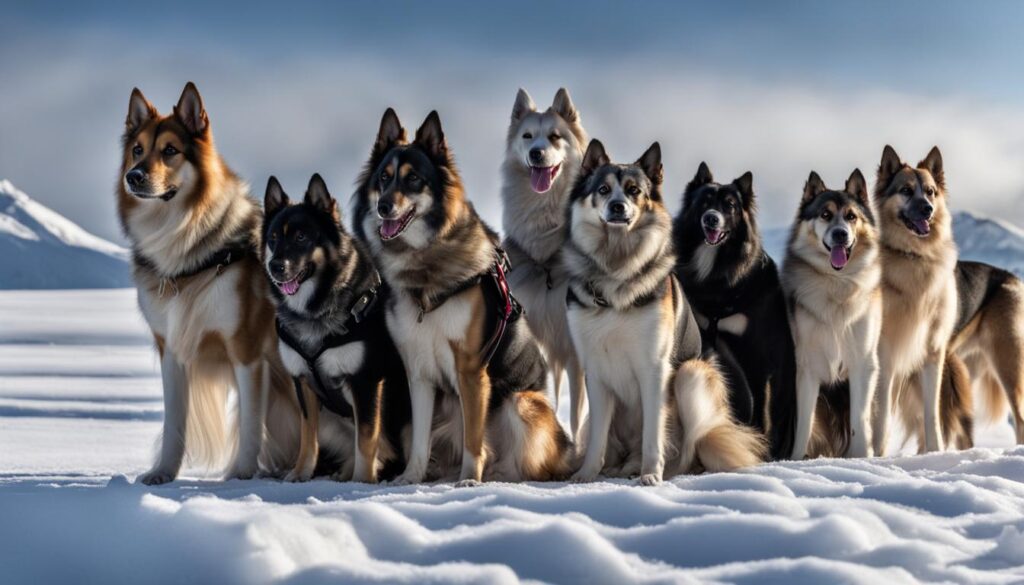
Conclusion
In conclusion, Winter Expedition Dogs, also known as Snow Dogs, are the unsung heroes of Arctic exploration. These incredible canines possess the unique characteristics, specialized training, and unwavering loyalty that make them indispensable companions and workers in the icy frontiers.
Throughout history, Winter Expedition Dogs have played a vital role in transportation, search and rescue operations, and providing heartfelt emotional support to expedition members. Their strength, endurance, and adaptability to extreme conditions make them invaluable assets in the challenging world of Arctic expeditions.
As we continue to embark on thrilling adventures and unlock the mysteries of the frozen polar regions, let us always remember and appreciate the important contributions of these remarkable Snow Dogs. Their unwavering determination and resilience deserve our utmost admiration.
FAQ
What are Polar Expedition Dogs?
Polar Expedition Dogs, also known as Arctic Exploration Dogs or Cold Climate Dog Breeds, are specially bred and trained dogs that play a crucial role in expeditions to the polar regions. They are specifically adapted to navigate extreme cold temperatures, harsh terrain, and challenging conditions.
What is the role of Polar Expedition Dogs in Arctic exploration?
Polar Expedition Dogs are the unseen heroes of Arctic expeditions. They are used as sled dogs to pull heavy loads across vast stretches of icy landscapes. They provide essential support, loyalty, and unwavering dedication to their human counterparts. These dogs also assist in search and rescue missions, scientific research, and provide companionship to expedition members.
How are Polar Expedition Dogs trained and prepared?
Polar Expedition Dogs, also referred to as Winter Expedition Dogs or Snow Dogs, undergo extensive training and preparation. They are bred and raised in cold climates to develop thick fur, strong muscles, and endurance. Training begins at a young age and focuses on obedience, physical fitness, and sled pulling techniques. These dogs are also taught survival skills and are acclimated to extreme temperatures and various types of terrain.
What makes Polar Expedition Dogs invaluable assets in Arctic expeditions?
Polar Expedition Dogs possess unique characteristics, specialized training, and unwavering loyalty that make them indispensable in the Arctic. Their strength, endurance, and adaptability to extreme conditions enable them to contribute significantly to transportation, search and rescue operations, and providing emotional support to expedition members. These dogs are invaluable assets in the challenging world of Arctic exploration.

